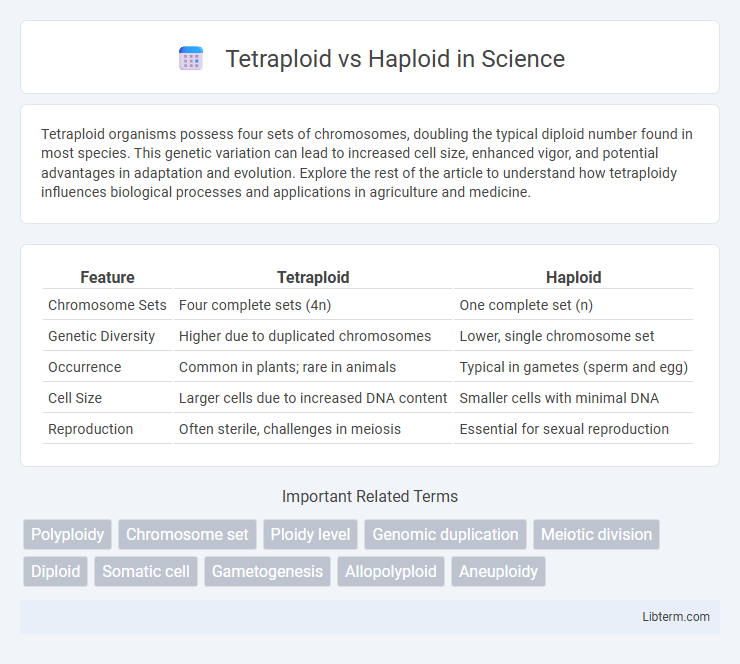Tetraploid organisms possess four sets of chromosomes, doubling the typical diploid number found in most species. This genetic variation can lead to increased cell size, enhanced vigor, and potential advantages in adaptation and evolution. Explore the rest of the article to understand how tetraploidy influences biological processes and applications in agriculture and medicine.
Table of Comparison
| Feature | Tetraploid | Haploid |
|---|---|---|
| Chromosome Sets | Four complete sets (4n) | One complete set (n) |
| Genetic Diversity | Higher due to duplicated chromosomes | Lower, single chromosome set |
| Occurrence | Common in plants; rare in animals | Typical in gametes (sperm and egg) |
| Cell Size | Larger cells due to increased DNA content | Smaller cells with minimal DNA |
| Reproduction | Often sterile, challenges in meiosis | Essential for sexual reproduction |
Introduction to Ploidy: Tetraploid vs Haploid
Ploidy refers to the number of complete sets of chromosomes in a cell, with haploid cells containing a single set (n) and tetraploid cells possessing four sets (4n). Haploid cells are crucial in sexual reproduction, as gametes carry one set of chromosomes, ensuring genetic diversity through fertilization. Tetraploid organisms often exhibit increased cell size and genetic variation, playing a significant role in plant breeding and evolutionary biology.
Definition of Tetraploid
Tetraploid cells contain four complete sets of chromosomes (4n), doubling the chromosome number found in diploid cells, while haploid cells have only one set of chromosomes (n), typical of gametes. Tetraploidy occurs naturally or through artificial induction in plants and some animal species, contributing to genetic variation and speciation. The increased chromosome number in tetraploids often results in larger cell size and greater metabolic capacity compared to haploid cells.
Definition of Haploid
Haploid cells contain a single set of chromosomes (n), representing half the genetic material found in diploid or tetraploid cells, which have two (2n) and four (4n) sets respectively. Haploid organisms or cells are essential in sexual reproduction, as they enable the fusion of genetic material during fertilization to restore diploid chromosome numbers. Understanding the haploid state is crucial in genetics, breeding programs, and biotechnological applications like plant breeding and evolutionary studies.
Chromosomal Differences: Tetraploid vs Haploid
Tetraploid cells contain four complete sets of chromosomes (4n), resulting in double the genetic material compared to diploid cells, whereas haploid cells have only one set of chromosomes (n), representing half the number of chromosomes found in diploid organisms. This chromosomal difference impacts cellular processes such as meiosis, genetic variation, and organismal development, with tetraploid organisms often exhibiting increased size and robustness due to the extra gene copies. In contrast, haploid cells are critical in sexual reproduction, serving as gametes that combine to restore diploid chromosome numbers in the offspring.
Occurrence in Nature
Tetraploid organisms, characterized by four sets of chromosomes, commonly occur in plants such as wheat and cotton, often resulting from genome duplication events or hybridization. Haploid organisms contain a single set of chromosomes and are frequently found in fungi, algae, and gametes of animals and plants, playing a crucial role in sexual reproduction. Natural occurrences of tetraploidy are less common in animals but more prevalent in plant speciation and adaptation processes.
Genetic Implications of Tetraploidy
Tetraploidy results in organisms having four sets of chromosomes, which can lead to increased genetic diversity and potential for evolutionary adaptability compared to haploids with a single chromosome set. This chromosome duplication in tetraploids enhances gene redundancy, allowing for mutations to occur without detrimental effects, potentially leading to novel gene functions. However, tetraploidy can complicate meiosis and impact fertility, influencing species' genetic stability and reproductive success.
Biological Significance of Haploidy
Haploidy, characterized by a single set of chromosomes, plays a crucial role in genetic diversity and evolutionary adaptation by enabling immediate expression of recessive alleles, which facilitates natural selection. It is essential in the life cycles of many organisms, particularly in gamete formation and sexual reproduction, allowing for the restoration of diploid chromosome numbers upon fertilization. In contrast, tetraploidy, with four sets of chromosomes, often results in increased cell size and genetic redundancy, influencing speciation and genetic robustness but differs fundamentally from the genetic simplicity and evolutionary benefits provided by haploid stages.
Applications in Plant Breeding
Tetraploid plants, containing four sets of chromosomes, are widely used in plant breeding to enhance traits such as increased size, improved stress tolerance, and greater genetic diversity compared to haploid plants, which possess a single set of chromosomes and serve primarily in accelerating the development of homozygous lines. The application of haploid induction techniques allows breeders to produce pure lines rapidly, facilitating quicker selection cycles and trait stabilization in crops like maize and wheat. Tetraploid varieties are particularly valuable in hybrid breeding programs and polyploidization strategies to increase yield and adaptability across various agricultural environments.
Advantages and Disadvantages
Tetraploid organisms possess four sets of chromosomes, offering advantages such as increased genetic diversity, enhanced cell size, and improved stress resistance, which benefit plant breeding and adaptation. However, tetraploidy can cause complications like reduced fertility due to difficulties in meiotic chromosome pairing and potential genetic imbalances. In contrast, haploid organisms, with a single chromosome set, enable rapid genetic studies and breeding through immediate expression of recessive traits but suffer from lower genetic variability and diminished robustness under environmental stress.
Key Differences: Tetraploid vs Haploid
Tetraploid cells contain four complete sets of chromosomes (4n), whereas haploid cells have only one set (n), making their genetic complexity and potential for variation significantly different. Tetraploid organisms exhibit increased cell size and often enhanced vigor or adaptability due to gene redundancy, while haploid cells, commonly found in gametes, facilitate genetic diversity through sexual reproduction. In agricultural biotechnology, tetraploid crops are utilized to improve traits like yield and disease resistance, contrasting with haploid cells' use in breeding programs for developing homozygous lines quickly.
Tetraploid Infographic

 libterm.com
libterm.com